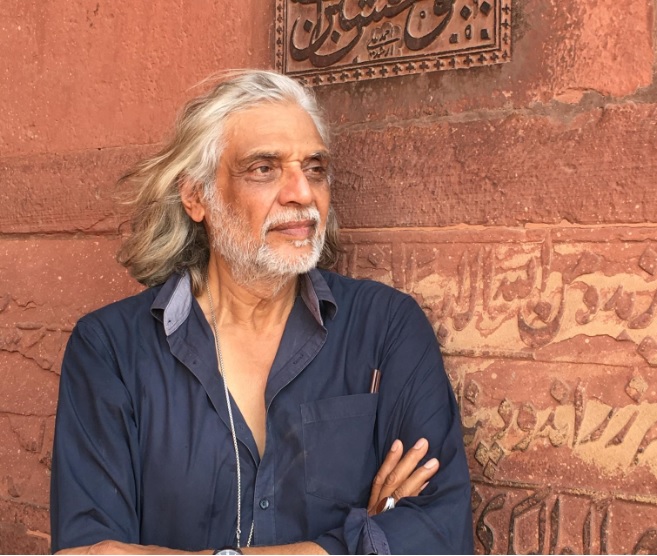Welcome to Samvaad, where art meets conversation, and inspiration knows no bounds. Here we engage in insightful conversations with eminent personalities from the art fraternity. Through Samvaad, Abir Pothi aims to create a platform for thought-provoking discussions, providing readers with an exclusive glimpse into the creative processes, inspirations, and experiences of these creative individuals. From curating groundbreaking exhibitions to pushing the boundaries of artistic expression, our interviews shed light on the diverse perspectives and contributions of these art luminaries. Samvaad is your ticket to connect with the visionaries who breathe life into the art world, offering unique insights and behind-the-scenes glimpses into their fascinating journeys.
In this episode of Samvaad, we have the privilege of sitting down with Ashish Agarwal, founder of Ashish Agarwal Interiors, a purpose-driven interior design firm based in Guwahati, Assam. Specialising in residential, commercial, retail, and office spaces of varying sizes, their portfolio reflects a commitment to creating environments that evoke human emotions and foster a sense of belongingness. From multinational corporations seeking growth-driven atmospheres to individuals envisioning their dream homes, Ashish Agarwal Interiors caters to a diverse clientele with meticulous attention to detail. Joining us for this insightful conversation is Nidheesh Tyagi from Abir Pothi, as we uncover the visionary insights driving the creative force behind Ashish Agarwal Interiors, shaping the landscapes of tomorrow. Please do check Part-1 (Click Here)
Nidheesh: So, you also happen to be in a very interesting place, like Guwahati, which seems to have a unique blend of a global aspiration and a strong local regional aesthetic. The whole Northeast has, to my mind, a huge, strong design aesthetic. Tell us about how Guwahati is changing. There’s a clear global aspiration to be contemporary and new, and at the same time, we want to keep things authentic, and original, and maintain local regional cultural sensibilities.
Ashish: Very well said, Nidheesh, and I must say you have a very quick observation in this. You just landed here today and you already observed that part. I must say it is the cusp of growth. There’s rampant construction happening in this part of India, especially Guwahati. So, Guwahati is not inspired by Eastern or a very specific area; it has been inspired by the entire India. Of late, I realised that in the last 10 years, the young generations have studied outside, not even in India, they have studied in Europe, the US, and everywhere. And this influence from everywhere, if you go and see the skyline of Guwahati, you will see there’s a lot of modern architecture happening. And there are a lot of bungalows with inclined roofs, which also give you glimpses of Assamese architecture. Of course, there is no one direction which is taking place; it is rampant, and it is a kind of chaos at the same time. But eventually, it’s going to be settled down to one design language, which is what we all want. But it’s good that Guwahati is doing well in terms of material, in terms of collaborations. And even if you travel 100 kilometres away from Guwahati, you’ll see this urban architecture which is coming up. People are already keen to keep those aesthetics from art, culture, heritage, everything. And the architecture is not urban or modern. So, there is a kind of balance which is being seen outside Guwahati or maybe outside the urban conditions.
Nidheesh: And how does this whole thing change? I mean, how do you see, as you know, when I was yesterday looking at Paltan Bazar and then this road where we are situated, GS (Guwahati-Shillong) Road, so you know, there are multiple timelines in the same city? So, how do you see this transition?
Ashish: All right, so I’ll take you back to the period when Guwahati city started evolving. So, Guwahati’s heart is a place where people used to trade in ancient times, by the river, by the bank of this River Brahmaputra. People from different tribes used to come and trade. So, Paltan Bazar, those fancy Bazar, and MG Road are the areas where Guwahati started growing up. So, you see the old city there till that point of time, and this part of Guwahati, GS Road, was very suburb and remote at that point of time. Eventually, the city grew towards the airport and your next state. So, this is the state highway, and eventually, this area was ready to come up, hence the acquisition and skyscrapers started coming up. So, you’ve seen modern architecture in this part of the city. Not that part of the city, any city you have old and the new one. So, this is what you see as two timelines and two different languages.
Nidheesh: So, one question which I had was about this whole integration of local art and craft into your design works.
Ashish: Yeah, my take on this is basically there’s no proper justification which has been done to the local art and craft and the traditional methodology, primarily because in terms of architecture, the Assam architecture was unique due to the climate conditions – it was very humid and hot with high rainfall, and of course, it is seismic zone 5. So, initially, the architecture was very different here; those columns were made out of tree trunks, and we used to have bamboo sheets, mud covered with mud, and thatch roofs. We could take a tremor of up to 6 to 7 on the Richter scale. But then, at the same time, it was not very sustainable in terms of longevity; it needed very frequent repairs. So, the transition to modern technology – concrete, brick, cement – those architectures started because it’s viable, it’s economical, it’s more long-lasting. So, in the whole transition, I feel we forgot the aesthetic or the charm of Indian Assam architecture. Hence, it is broadly missing if you travel across the major cities; all the buildings are modern, similar to what you see in the rest of India. So, I think we are responsible as well as the government are responsible for not keeping the flavour alive.
Nidheesh: So, we were talking about how people are changing so fast and when you approach a project, we were talking about the markets, and now let’s move to the people, how their design needs are so different from what they were, say, one generation back, and how they are looking at the next generation. How the Indian house has changed in a way. Like, when I kind of grew up in Chhattisgarh in government quarters, there were no bedrooms; they were all like every room was a living room. So, the bedroom came, and then the attached bedroom came, and so this is how the houses evolved. And then now, we can’t probably think about a modern, even middle-class kind of house which will have that kind of thing. So, these changes are happening very fast. How do designers keep that in mind in their own works, that how the Indian families, the middle class, and also the high-end people, all of that is changing? How do design people configure this change?
Ashish: All right, interesting question, Nidheesh. I would say it is a demand-and-supply situation where we have to fit in. The occupants, the builders, the architects, the city which is developing fast, everybody tries to strong in there and to board that bus and speed up their life. The same is the condition of Guwahati city, I would say. Guwahati is an image of the entire Northeast, hence I’m just mentioning Guwahati. Land is getting scarce, space is getting crunched, and buildings are going taller. So eventually, what square feet you have to design is very compact. Of course, the needs are getting different. People have started adapting to the smaller spaces because they’ve been experiencing this scarcity of land everywhere in India. So, we have to deal with it with a different approach. Of course, if you move away from the urban cities, then we have more palatial space, and then we can have a lot of retreats and resorts coming around this country; you can always have that countryside expansion and experience whatever. But Guwahati, so far, we have to deal with those small areas. And of course, in terms of architecture, it is going to be difficult to adopt the flavours or the heritage or art brought to the buildings, whereas, in terms of interior designing, there might be some possibility that we can explore.
Nidheesh: Who are the interior designers you feel most inspired by? I mean, who are these four or five people you look at in India and globally? I mean, who are the people from where you draw your inspiration from?
Ashish: Okay, Zubin and Krupa are the couples which I really follow. They are based out of Mumbai, an architect couple, and they do really good, sensible design, I would say. There’s nothing in the context of heritage or ancient architecture, but then whatever they are doing with urban conditions, I get a lot of inspiration from them. Also, my previous employers or my mentors, their words are still striking my ears, and you know, I remember all those things and I just try to incorporate them. At the same time, art also inspires a lot. So, I’ve been to exhibitions, I’ve travelled to Europe, and there has been a very lot of great experience, the inspiration you’ve been getting from art, museums, architecture from Europe, and we try to blend them here, somewhere or the other way, in our design as well. I get inspiration from music as well when I design, so AR Rahman is one of my biggest inspirations so far. I don’t know if I can put words to that, the kind of different music or the instruments he uses to bring together and create unique music. When I’m stuck, I just remember him; I get a different code of thinking and then I take this challenge and am always there to solve it. One of the biggest inspirations is AR Rahman.
To be continued…
Was Guwahati Ready for Retail Design? Ashish Agarwal’s Journey Proclaims the Answer (Part-1)






